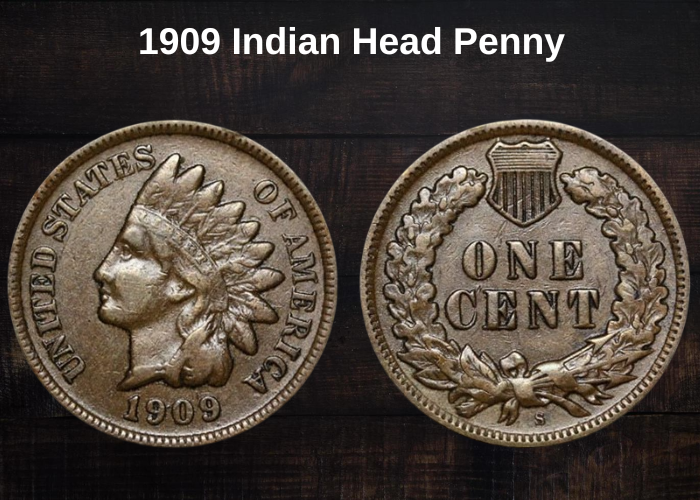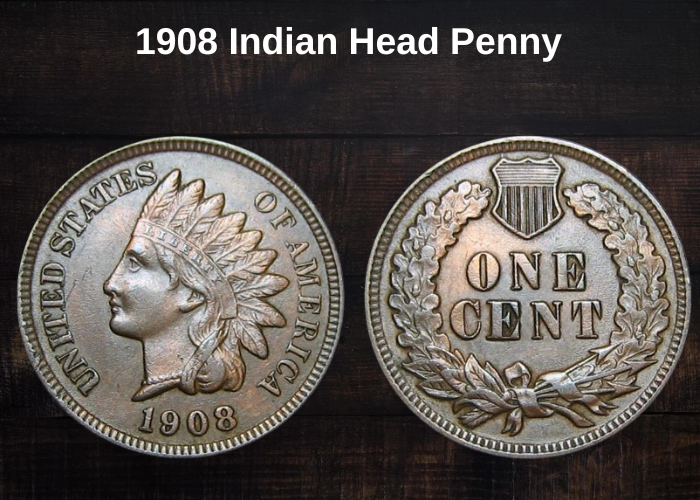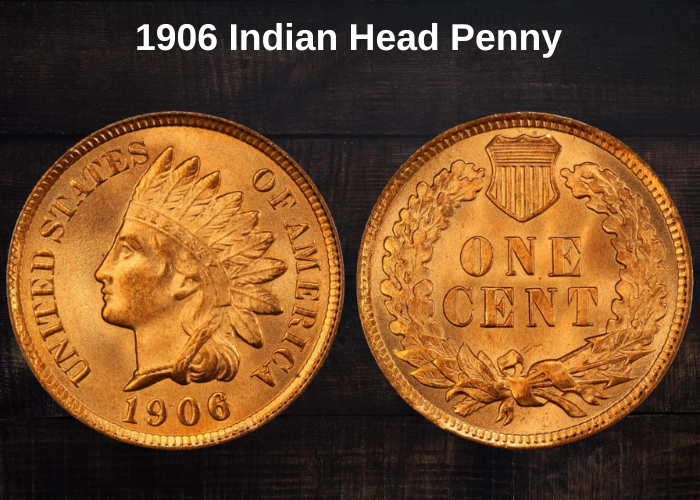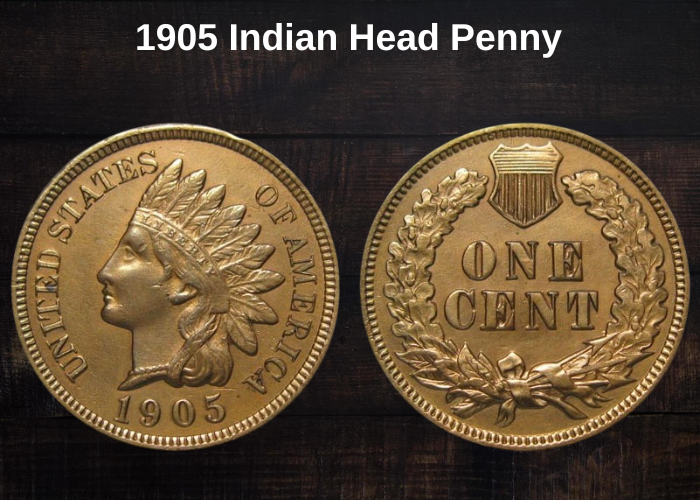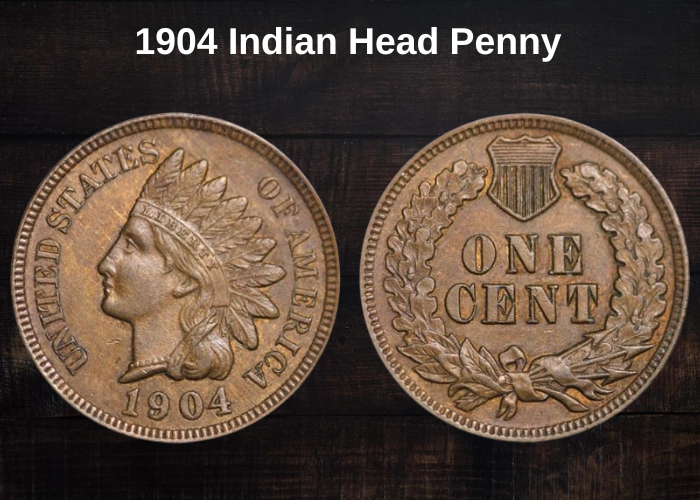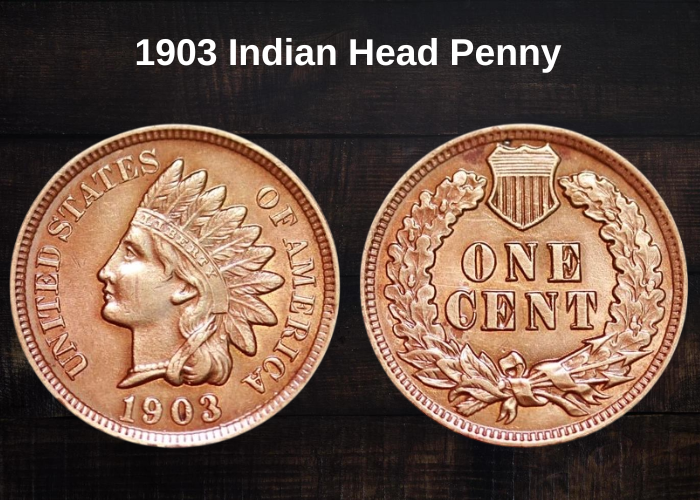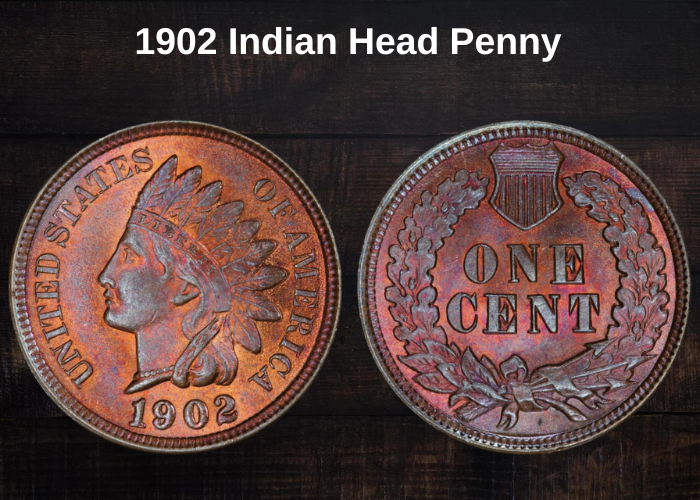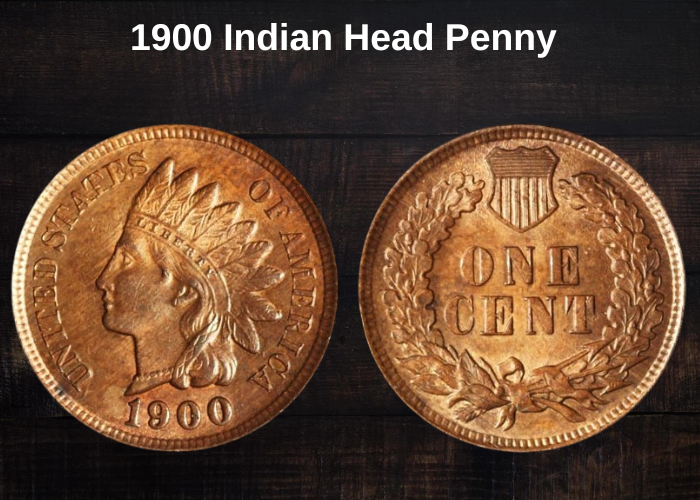The 1897 Indian Head Penny is part of a coin series minted between 1859 and 1909. These coins are highly valued by collectors due to their age, historical significance, and affordability.
But how valuable is your 1897 Indian Head Penny?
Its worth depends on several factors, and in this article, we’ll break down all the essential details. We’ll also cover grading standards, notable errors, and answer some frequently asked questions. Keep reading to learn more!
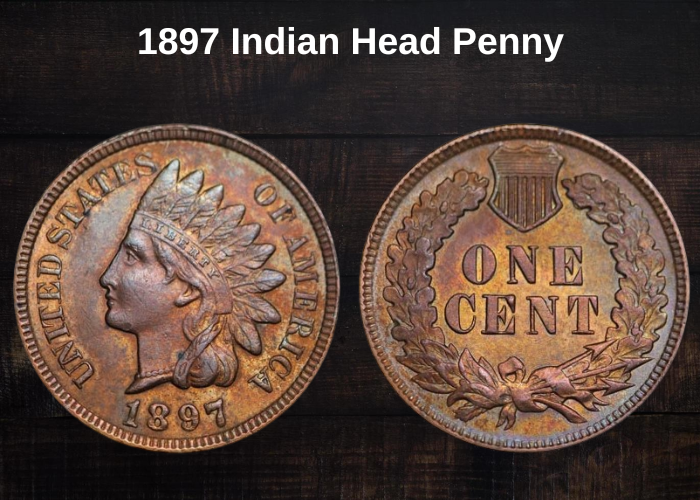
1897 Indian Head Penny Value Chart
The value of the 1897 Indian Head Penny varies based on its grade. Below is a price chart based on standard reference values for the red version of the coin:
| Coin Grade | MS/PR60 | MS/PR63 | MS65/PR67 | MS67/PR68 |
|---|---|---|---|---|
| 1897 No Mint Mark Indian Head Penny | $80 | $200 | $1,000 | $14,500 |
| 1897 No Mint Mark Proof Indian Head Penny | $225 | $400 | $1,200 | – |
These prices are based on market trends and may vary depending on demand, rarity, and specific coin characteristics.
1897 Indian Head Penny Grading
If you’re new to coin collecting, you might be unfamiliar with grading terms like ‘MS67’.
Here’s a quick breakdown:
- The numerical grade ranges from 1 to 70, where 1 represents a coin in terrible condition, and 70 signifies a perfect coin.
- The ‘MS’ (Mint State) designation applies to coins meant for circulation, but only those graded 60 or higher.
- The ‘PR’ (Proof) designation is used for specially made collector coins that were never intended for circulation.
Coin Grading Scale
| Grade | Description |
|---|---|
| 1 | Basal State-1 |
| 2 | Fair |
| 3 | Very Fair |
| 4-6 | Good |
| 7-10 | Very Good |
| 12-15 | Fine |
| 20-30 | Very Fine |
| 40 | Extremely Fine |
| 50 | About Uncirculated |
| 60+ | Mint State |
| 65 | Mint State (High Grade) |
| 70 | Mint State (Perfect Condition) |
Knowing your coin’s grade is essential for determining its true value. Check out our grading guides to learn more!
1897 Indian Head Penny Value By Mink Mark
There are currently six active mints in the United States, but it wasn’t always this way. The Philadelphia Mint was the first US mint ever established, and for a long time, it was the only facility responsible for producing coins. This was the case when the 1897 Indian Head Penny was struck.
Because of this, there are only two main varieties of the 1897 Indian Head Penny:
- The standard circulation coin (No Mint Mark)
- The proof coin, made specifically for collectors
In total, over 50 million pennies were minted in 1897, with the vast majority being the regular 1897 No Mint Mark Indian Head Penny.
Design and Composition
- Designer: James B. Longacre
- Metal Composition: 95% copper, 5% tin and zinc
Now, let’s explore each variety in more detail!
1897 No Mint Mark Indian Head Penny Value
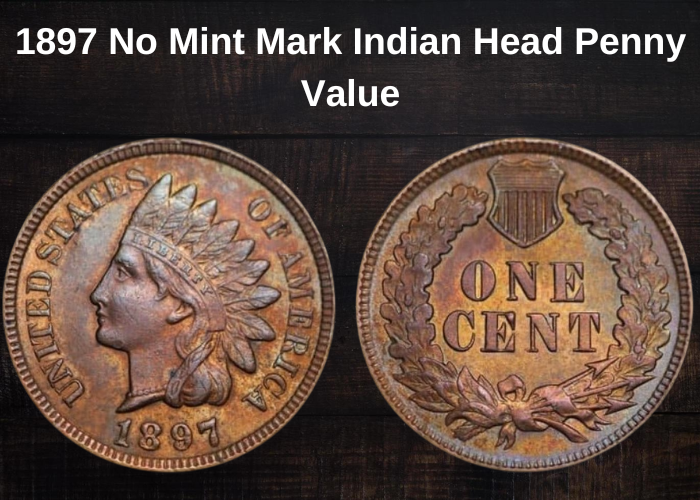
For most coins, scarcity and grading are the primary factors that determine their value, as higher-grade coins are usually rarer. However, when it comes to Indian Head Pennies, there’s a third key factor to consider: color.
Indian Head Pennies are classified into three color designations, which can significantly impact their value:
- Brown (BN)
- Red-Brown (RB)
- Red (RD)
We’ll dive into these color classifications in more detail shortly!
The total mintage for the 1897 No Mint Mark Indian Head Penny was 50,464,392. While this number may seem high, especially compared to modern coin production (which can exceed a billion coins per year), it’s still significant for a coin over 100 years old.
Because of this high mintage, worn 1897 Indian Head Pennies are still widely available today. If your coin is in poor condition with noticeable wear, dents, and scratches, its value will likely be just a few dollars.
Why Indian Head Pennies Are Popular
One reason collectors love Indian Head Pennies is their affordability. They offer a chance to own a piece of American history without spending a fortune. Even completing a full set of these coins is achievable for collectors on a budget.
When Does an 1897 Indian Head Penny Become Valuable?
The real value of these coins starts at higher grades:
- A coin graded 20 (“Very Fine”) still shows moderate wear but retains decent details.
- A coin graded 50 (“About Uncirculated”) may look nearly perfect to the untrained eye, but there are 20 grades above this!
- At MS65, coins become significantly valuable—with prices around $1,000, depending on their color.
- At MS67, values can skyrocket to $14,500 due to their rarity.
Record Sale & Color Impact on Value
The record price for an 1897 Indian Head Penny is $45,600, which was achieved in 2019 for an MS67 coin with a bright red luster.
One of the biggest factors in determining value is the coin’s color:
- Brown (BN) – Most common, least valuable.
- Red-Brown (RB) – More desirable, worth roughly twice as much as BN coins.
- Red (RD) – The most valuable, often twice as valuable as RB coins.
For example, an MS66 Red-Brown (RB) coin might be worth $1,450, while the same coin in Red (RD) could be worth $4,000!
These numbers are rough estimates, but they illustrate how important color is when assessing the value of an 1897 Indian Head Penny.
1897 No Mint Mark Proof Indian Head Penny Value
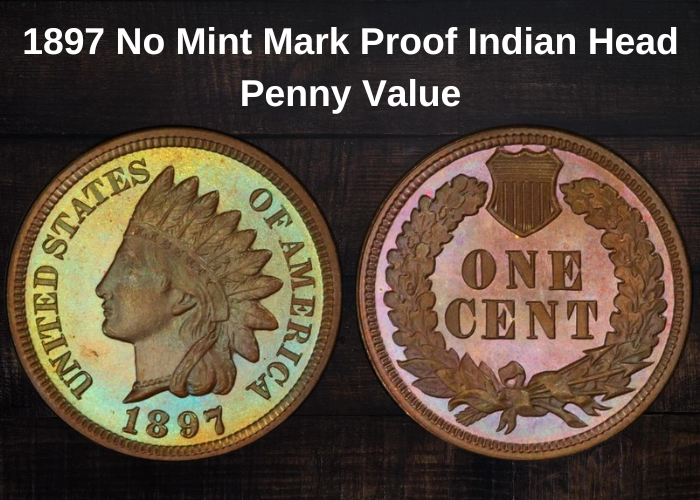
In modern times, proof coins are typically produced specifically for collectors and sold without ever entering circulation. Each year, millions of proof coins are generally minted, designed to meet collectors’ needs.
Proof Coins in 1897
Back in 1897, proof coins had a different purpose. They were created mainly to ensure the dies were striking the coins correctly and for archiving purposes. Because of this, only a small number of them were produced—just 1,938 1897 Proof Indian Head Pennies were minted.
Why Proof Coins Are Valuable
Proof coins are designed to be perfect examples of the coinage, with their high-quality design features. Since these coins were never intended for circulation, they are expected to be in excellent condition. This makes proof coins valuable, but only in the highest grades.
A clear way to tell if a coin is in excellent condition is by looking at the design details. For instance, on the headdress of the American Indian figure, you’ll see the word “LIBERTY.” If this lettering is clearly visible, it means the coin has minimal wear and a good strike.
High-Grade Proof Coins
The highest grade for proof coins that you can easily find is MS67. With a mintage as low as 1,938 coins, these can fetch around $12,000 on average. In fact, the highest price recorded for an MS67 coin was $108,000 in 2021.
While MS68 coins do exist, they are rare and not often sold. The last time one was sold through official auctions was over 11 years ago, making it difficult to determine their exact value, but they could potentially fetch at least $12,500 if in good color.
Value of Lower-Grade Proof Coins
Due to their scarcity, even proof coins in lower grades can still be worth far more than their face value. In mint condition, you can expect sales of $225 at the minimum. If you own a proof coin, it’s always a good idea to have it officially graded for a more accurate valuation.
Whether you have a regular 1897 No Mint Mark Indian Head Penny or a proof coin, it’s easy to see why these pieces are beloved by collectors.
Rare 1897 Indian Head Penny Error List
We’ve discussed how coins in excellent condition can be worth a lot, but another way to increase a coin’s value is through minting errors. Coins with mistakes during the production process are highly prized by collectors, and some errors can make a coin much more valuable. Let’s explore some of the common errors found on the 1897 Indian Head Penny.
1.- Neck Protrusion
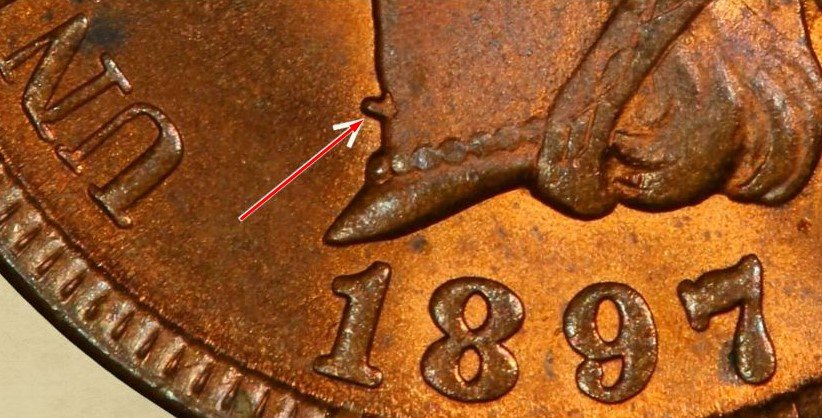
The most well-known error on the 1897 Indian Head Penny is the ‘1 in Neck’ error, which appears on several coins, though it is more common on those in lower grades.
This mistake occurred when the date was punched onto the coin twice. The first punch placed the date in the middle of the coin, but then the second punch, which was meant to fully cover the date with the portrait, didn’t always line up properly. As a result, part of the ‘1’ from the year 1897 can be seen sticking out from the neck of the portrait.
On coins that are heavily worn, this error may be worth around $30, but if the coin is in better condition, it can be valued at over $3,000.
2. Double Strike
A double strike is a common error found on many coins from various years. After a coin is struck, it is supposed to be ejected so a new planchet (blank coin disk) can take its place.
However, this doesn’t always go as planned. Sometimes, the coin fails to eject properly and gets struck again, causing the design to be reprinted, often off-center. The value of these coins depends on the size of the error, but generally, they are worth $300 or more.
3. Repunched Date
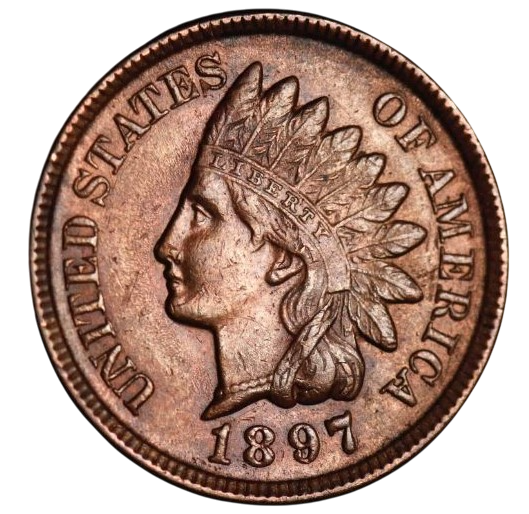
Sometimes, the date on a coin gets punched twice, but it doesn’t always land in the exact same spot. These errors are often so subtle that someone not actively looking for them might not notice.
At their most noticeable, the numbers overlap, creating a “shadow” effect. However, in most cases, the numbers just appear thicker than normal.
Repunched dates are highly desirable among collectors, and they can often be worth at least $150. In rare cases, they can fetch much higher amounts. For example, one particularly well-rated repunched date coin sold for over $30,000.
Where to Sell Your 1897 Indian Head Penny ?
Now that you’re aware of your coin’s value, the next step is knowing where to sell them online. There are several reliable platforms where you can sell your coins easily, and here are some of the best options:
1. eBay
- Introduction: eBay is one of the largest online marketplaces where you can auction or sell coins to a global audience.
- Pros:
- Huge audience with international buyers.
- Auction format allows for potentially higher sales.
- Flexible selling options.
- Cons:
- Seller fees can be high (up to 10% or more).
- Requires good photography and detailed listings for success.
- Risk of counterfeit returns if not properly authenticated.
2. Heritage Auctions
- Introduction: A premier auction house for rare coins and collectibles.
- Pros:
- Specializes in rare and high-value coins.
- Expertise in evaluating rare coin collections.
- Provides professional auction services and high visibility.
- Cons:
- High seller fees (up to 20%).
- Suitable mostly for high-end coins rather than common or low-grade pieces.
- May require you to meet certain minimum valuation requirements.
3. GreatCollections
- Introduction: An online auction site dedicated to rare coins.
- Pros:
- Auction format with a focus on coins.
- Offers a secure and trusted platform for buyers and sellers.
- No seller fees for coins over a certain value.
- Cons:
- Might not be suitable for smaller collections.
- Can be more selective about which items are accepted for sale.
4. CoinTalk Marketplace
- Introduction: A niche forum specifically for coin collectors to buy and sell coins.
- Pros:
- Community-driven platform, often with knowledgeable buyers.
- Lower fees than auction platforms.
- Cons:
- Limited audience compared to larger platforms like eBay.
- Some trust issues with buyers/sellers if you don’t carefully vet them.
5. CoinBuyer
- Introduction: A site that connects sellers with coin buyers directly, without an auction format.
- Pros:
- Easy and direct selling process.
- Buyer networks are well-established for fair pricing.
- Cons:
- May not fetch the highest price compared to auction-style platforms.
- Limited in terms of exposure for certain types of coins.
These platforms cater to different types of sellers, so choose one based on the type of coin you’re selling and the potential for reaching interested buyers. Always research the best approach for your specific collection to ensure a smooth and profitable transaction!
1897 Indian Head Penny – FAQs
1. Is an 1897 Indian Head penny worth anything?
Yes, the value of the 1897 Indian Head Penny depends largely on its condition. Coins in higher mint state grades can be quite valuable. Despite being over 100 years old, many of these coins are still available in lower grades. If your coin is worn or damaged, it may only be worth a couple of dollars. However, well-preserved or high-grade coins can be worth much more.
2. What is the error on the 1897 Indian Head penny?
The 1897 Indian Head Penny has three major errors:
- ‘1 in Neck’ Error: A mis-punched date where part of the ‘1’ is visible in the neck of the portrait.
- Repunched Date: The date was punched more than once, often resulting in overlapping numbers or a shadow effect.
- Double Strike: The coin was struck twice, resulting in an off-center pattern.
If you find any of these errors on your coin, it could significantly increase its value, with error coins in mint condition reaching thousands of dollars.
3. What is the rarest Indian Head penny?
The rarest Indian Head penny in terms of low mintage is the 1909-S Indian Head Penny, with only 309,000 coins struck. This makes it difficult to find, especially in mint condition. However, any Indian Head Penny in high grades (like MS67 or MS68), especially those with red coloring, can be considered rare and valuable.

